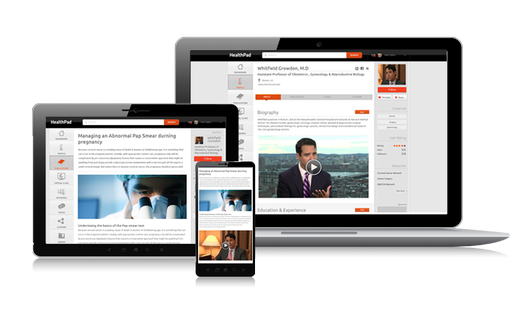Tag
Directory:
Tags:

|
Patients want health information in ways that doctors are not providing.
Patients want reliable answers to simple questions about the presentation, diagnosis, treatment options, side effects, and aftercare of their conditions. They want answers at speed, and increasingly delivered to their smartphones in video formats. With difficulties gaining face-time with doctors, patients turn to the Internet. Worldwide, some three billion health-related Internet searches are made each year. Patients experience difficulty finding reliable answers to their basic questions among more than two billion health websites. According to research published by the American National Institute of Health, 33% of adults who search the Internet for health information become confused by what they find. This frustrates their therapeutic journeys and makes for fraught doctor-patient relations. Things are changing, however, and now patients have a new free-and-easy-to-use online platform, www.healthpad.net. This provides patients with video answers to their FAQs that can be accessed at speed at anytime, from anywhere on any hand held device. |
|
|
|
|
|
|

We have always been and always will be married to our own health. In the future, however, we will be taking greater responsibility for it. The British government is encouraging more people to use modern technology to increase control over their health. Under the new UK NHS Mandate launched on 14th November 2012 by Health Secretary Jeremy Hunt, patients will be encouraged to give feedback on the quality of their care, so others can then choose between hospitals. By 2015, modern communications technology is expected to play a substantially bigger role in the UK’s healthcare system and a significant proportion of patients will be booking GP appointments online and ordering repeat prescriptions over the internet. Launching The Mandate, Hunt said: “Never in its long history has the NHS faced such rapid change in our healthcare needs, from caring for an older population, to managing the cost of better treatments, to seizing the opportunities of new technology.”
The UK Mandate marks the beginnings of a redefinition of health and healthcare away from its focus on disease towards a focus on patients and individual wellbeing. A significant driver of this shift is the rising cost of care. In January 2012, Standards & Poors published a report suggesting that the creditworthiness of leading developed countries would be in jeopardy if they did not stem the escalating cost of healthcare. Highlighting the US, Germany, the UK and France, it said: “We project that healthcare costs for a typical advanced economy will stand at 11.1 per cent of GDP by 2050, up from 6.3 per cent of GDP in 2010.”
In the US, which is richer than other countries, the situation is particularly bad and Americans are willing to spend more on healthcare. In 2000 US healthcare was 13.8% of GDP, by 2010 it had increased to 19.8%. Over the past 40 years, healthcare costs in the US have been rising significantly faster than the overall economy or personal incomes, a trend that cannot continue forever. Americans pay hospitals and doctors more than most patients do in other rich countries. US insurance incentives entice doctors and patients to use expensive medical services more than is often warranted. Americans rely more on costly specialists, who tend to overuse advanced imaging technologies and resort to costly surgical or medical procedures a lot more than doctors do in other countries. This suggests that wealth as well as aging is a significant driver of health costs.
As advanced industrial economies become wealthier, their healthcare spends converge with that of the US. According to Stuart Fletcher, the CEO of BUPA, British patients are increasingly bi-passing health insurance companies and paying private hospitals and specialists directly and specialist fees are continuing to rise. Rising fees and the relative lack of competition and transparency among private hospitals slows the rate that people take up private health insurance. In the medium-term this, says Fletcher, will create an “affordability crunch”. BUPA’s European and US business saw half year profits for Europe and North America fall by 22%. BUPA has responded to the changing market conditions by offering patients more power and greater choice. BUPA is trialling a new scheme where it acts as a broker for patients, helping them negotiate the best price and quality of treatment on 70 common conditions.
This is not only an issue for health insurers. In most countries healthcare expenditure is rising twice as fast as economic growth. This suggests that unless something is done to change the situation, healthcare systems are economically unsustainable and this will inevitably lead to healthcare programmes being either reduced or cut. Healthcare costs are set to escalate further because of the worldwide pandemic of chronic non-communicable diseases: cancer, diabetes, heart and respiratory conditions. Margaret Chan, the Director General of the World Health Organization views chronic non communicable diseases as “The biggest threat to the 21st Century”. Today, 60% of all deaths are due to these diseases: twice the number due to communicable diseases. However, this is not only about mortality, it is also about morbidity and dependency and the economic impact on both treatment and lost productivity, which has been estimated to be nearly US$50 trillion over the past 20 years.
Richard Saltman, Professor of Public Health at Emory University in the US, said a key theme as governments seek to curtail healthcare costs, would be “rethinking the balance between collective and individual responsibility.” This raises the prospect in many countries of people being expected to take greater charge of their own health and this is what the new UK NHS Mandate is nudging towards.
Patient focused healthcare means a shift away from reactive medicine comprised of diagnosis and treatment. Reactive healthcare systems primarily treat patients after the onset of disease; incur significant costs and usually do not restore patients to perfect health. To be sustainable, healthcare systems will have to go further than the new UK NHS Mandate. They will have to be redefined away from prevention and treatment of illness to one of promoting well-being. This places a greater importance on mental illness and on complementary and traditional medicine and shifts the emphasis away from hospitals and clinics towards less traditional places including the home where individuals will be better positioned to take control of their own health.



